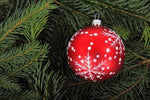
Different types of Christmas trees: Tips for the perfect choice this holiday season
, 5 min reading time

, 5 min reading time
#VALUE!
The holidays are approaching and it's time again to fill our homes with the smell of a beautiful Christmas tree. But with so many options, choosing the perfect tree can be a challenge. From traditional conifers to modern alternatives, there is something for everyone. Let's explore the different types of Christmas trees together and discover which one suits us best.
We all know that a Christmas tree is more than just a decoration; it is the center of our festive traditions. Whether we choose a classic Nordmann spruce or a fragrant Blue Spruce, each tree has its unique charm and benefits. In this guide we delve into the properties of popular Christmas tree varieties, so that we can make an informed choice for a bright Christmas.
There are a wide variety of Christmas trees available, each with unique features and benefits. Choosing the right tree can create a festive atmosphere.
Choosing the right Christmas tree enriches our interior and brings the Christmas atmosphere to life. Different types offer different benefits. Traditional conifers such as the Nordmann spruce are known for their needle strength, while the Blue spruce has a beautiful color. Those looking for alternatives can consider artificial trees.
When choosing a natural Christmas tree, appearance and scent play an important role. Natural trees bring an authentic atmosphere to your home.
The Nordmann Spruce is known for its needle resistance and dark green color. This type of Christmas tree hardly loses needles, making it ideal for a long Christmas period. The sturdy branches make it easy to hang heavier Christmas decorations.
The Blue Spruce or Picea pungens stands out because of its unique blue-gray color. This sturdy Christmas tree has sharp needles and a characteristic scent. Because the Blue Spruce is strong, it can support heavy decorations without bending.
The Norway spruce, also known as Picea abies, is a classic choice for many households. This tree is known for its strong pine scent and is easier to decorate due to its flexible branches. Although the needle retention is less good, the scent of the Norway spruce brings a nostalgic Christmas atmosphere into your home.
Artificial Christmas trees offer a modern alternative to traditional Christmas trees. They combine durability with ease of use, which makes them attractive to many families during the holidays.
Artificial Christmas trees give us the opportunity to use the same tree year after year. This not only saves costs but also the effort of searching for a suitable tree every year. In addition, artificial trees are less messy because they do not lose needles. Their fire safety is an important advantage, especially with children and pets in the home.
Material plays a crucial role when choosing artificial Christmas trees. PVC and PE are the most common materials. PVC trees are often cheaper and are seen in many living rooms because of their light weight and flexibility. PE, a stronger material, offers a more realistic appearance because the branches better mimic the shape of natural needles.
In this section we focus on the unique characteristics of different Christmas tree species to provide a more detailed insight into their appeal.
Each Christmas tree variety offers a unique combination of scents and colors. The Blue Spruce, for example, stands out because of its blue-gray needles that provide a beautiful color contrast in the living room. This tree retains its color and charm throughout the season. For lovers of classic Christmas scents, Norway Spruce offers the aroma that recalls traditional Christmas celebrations. The scent fills the room and enhances the festive atmosphere. The Nordmann fir, popular for its needle retention, also has a subtle pine scent that contributes to the Christmas atmosphere without being overpowering.
Christmas trees are available in a wide range of sizes, ideal for any space. Large Nordmann spruces fit well in spacious living rooms, while smaller Blue spruces look great in cozy corners or apartments. These various sizes make it possible to choose a suitable Christmas tree for every room, creating a personal Christmas atmosphere.
From an ecological point of view, artificial Christmas trees offer clear advantages. Unlike traditional trees, artificial trees can be reused for years. This reduces waste and prevents the annual felling of living trees. Moreover, artificial trees are easy to maintain, which means less clutter in our homes.
However, natural Christmas trees also have their environmental benefits, especially when they come from sustainable farms. These trees are grown especially for Christmas and contribute to CO2 absorption during their growth. After use, natural trees can be recycled into mulch or compost, which is beneficial for the soil.
When choosing a sustainable Christmas tree, it is important to consider the long-term impact on the environment. By choosing a quality artificial tree, we contribute to a more sustainable Christmas party. Their range offers several eco-friendly options that combine both style and sustainability.
Choosing the right Christmas tree is a personal and meaningful decision that contributes to the festive atmosphere in our home. Whether we choose the classic charm of a natural tree or the practical benefits of an artificial Christmas tree, there are plenty of options to suit our style and needs.
Let's enjoy the magic of Christmas with a tree that suits us perfectly and transforms our home into a warm and inviting place for the holidays.




499,00

16,50
In almost all cases you will receive a track & trace code within 48 hours, unless a longer delivery time is stated on the product page. You can easily track your order with this track & trace code.
In almost all cases you will receive a track & trace code within 48 hours, unless a longer delivery time is stated on the product page. You can easily track your order with this track & trace code.